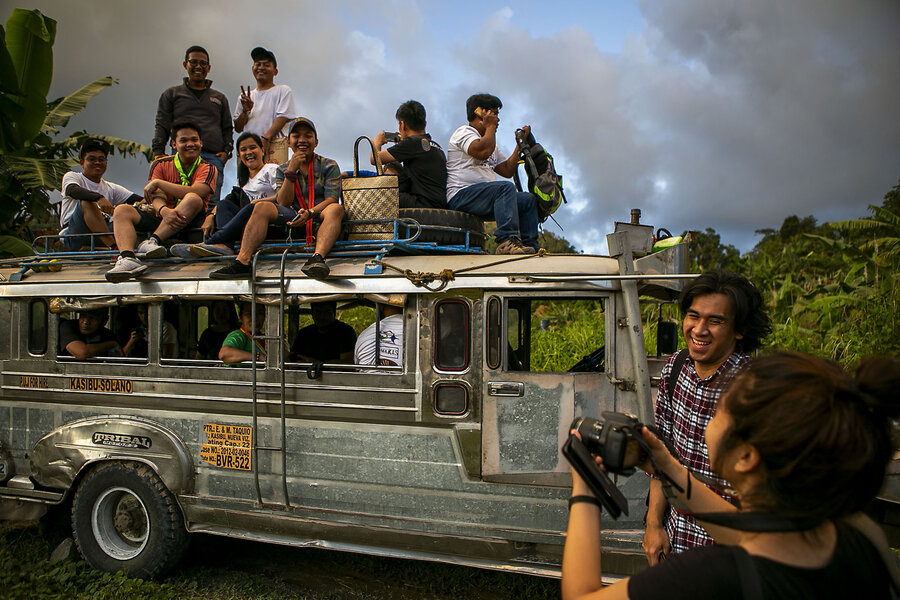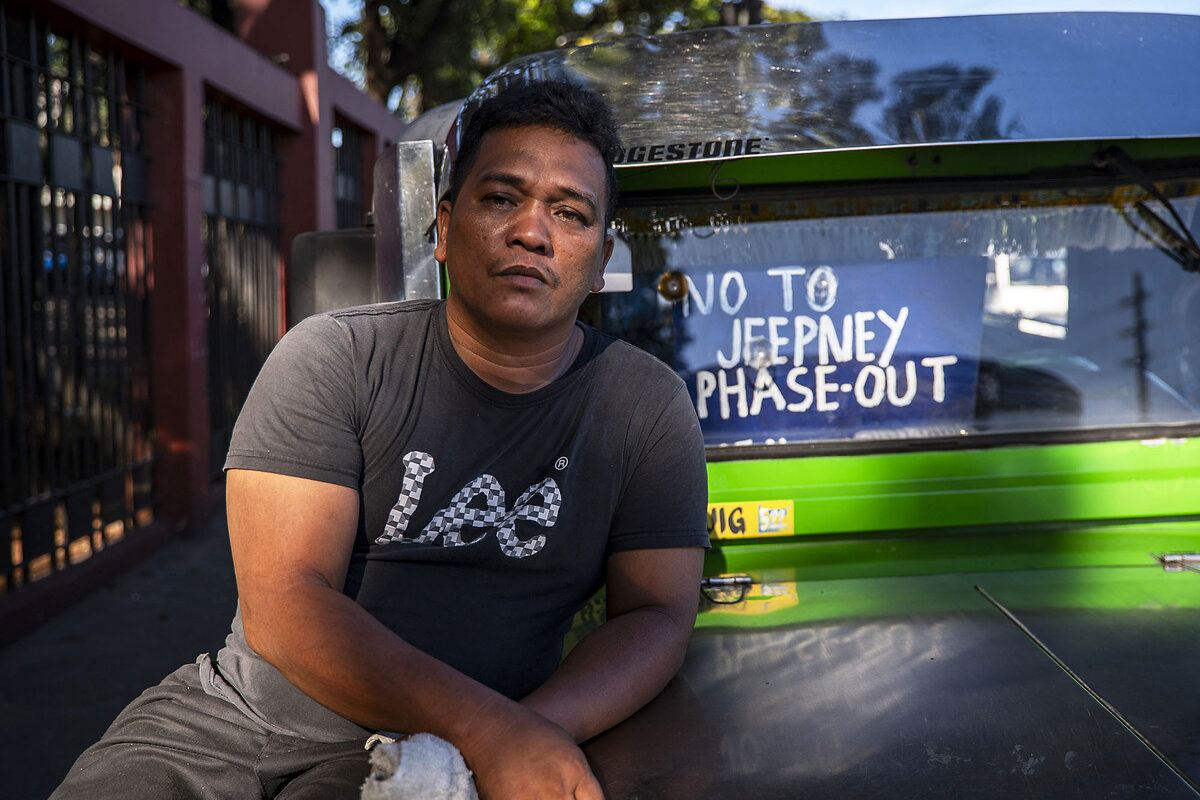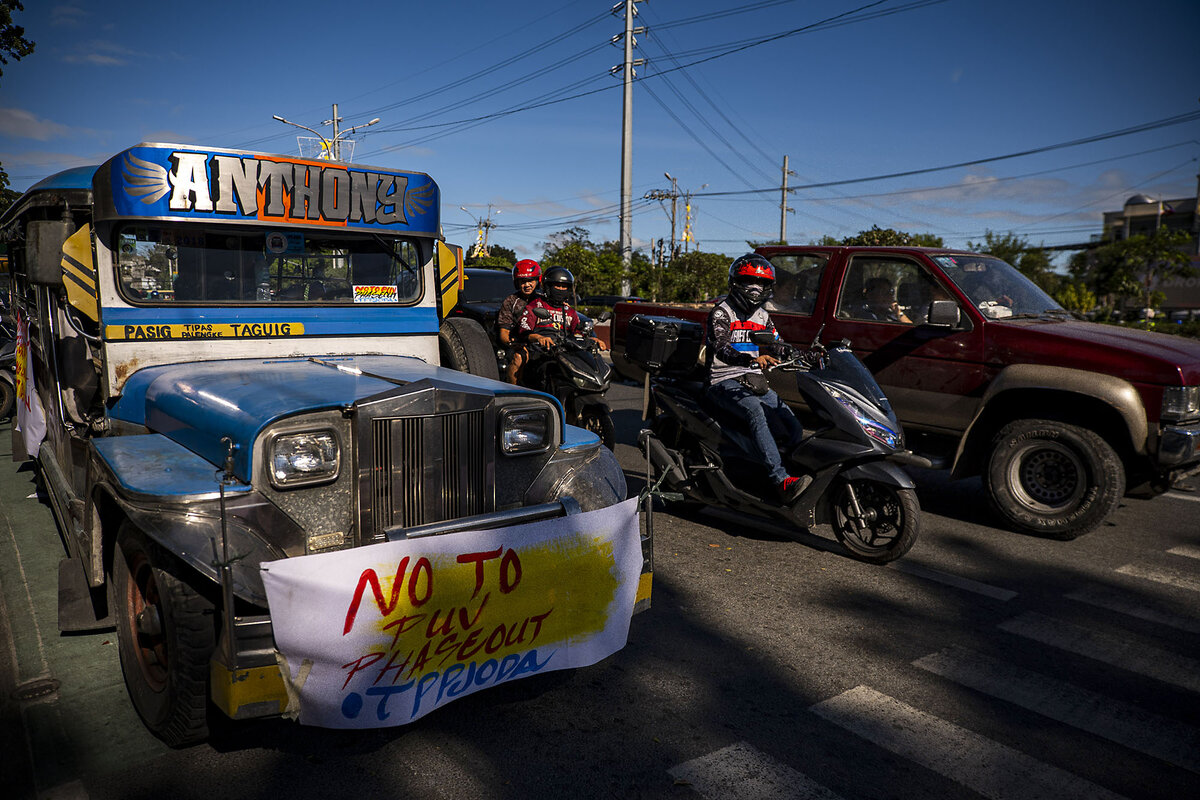In the Philippines, jeepneys rule the road. But for how much longer?
Loading...
| Manila, Philippines
Metal dragons roam the streets of Manila.
They came here decades ago from North America, and have since evolved into something uniquely Philippine. Every day, millions of people hop on and off the ornate beasts, derived from surplus World War II U.S. jeeps. In fact, the country’s transit system depends on them.
Not only are jeepneys the most popular form of public transportation in and beyond the capital, but these abandoned U.S. military jeeps-turned-mega cabs have also come to symbolize Filipino resilience and creativity.
Why We Wrote This
A story focused onEfforts to modernize the Philippines’ disjointed transit system present a complicated cost-benefit analysis, one that pits a beloved piece of Filipino culture – and the livelihoods of its keepers – against the need for safe and sustainable transportation.
Now, operators say, this heritage is under threat. In an effort to streamline transportation, the government is requiring jeepney operators to surrender their individual franchises to larger cooperatives, and replace traditional jeepneys with more energy-efficient vehicles. The deadline to comply was recently extended – for the last time, say officials – to April 30. While most jeepney drivers say they support the program’s environmental and public safety aims, many argue that its implementation will wipe out thousands of small-scale operators – and with them, jeepney culture.
Carlos Conde, senior researcher at the Asia Division of Human Rights Watch, says the jeepney system has always been flawed, known as much for reckless driving and overcrowding as it is for colorful cars and cheap fares. It thrived, Mr. Conde says, because the government left the burden of public transit planning to the private sector.
“Jeepney, and the extensive use of it, was supposed to be a Band-Aid solution,” he says, “but it has become a way of life.”
Ode to Filipino maximalism
Rodolfo Molina was raised by a jeepney driver. Over the decades, he has witnessed the four-seater surplus army jeeps get stripped down and reinvented into today’s iconic passenger transporters, which can hold up to 30 people. More, if passengers sit on the roof.
“My childhood life practically revolved around the jeepney,” he says. “Everyday, I watched them come and go. Some with artful designs, some with anime characters or religious images painted on the walls.”
Historian Francis Gealogo says jeepneys are a reflection of “Filipino maximalism,” their vibrant embellishments “derived from the way Filipinos designed their carriages during the Spanish era.”
“We used to call [the jeepney] the horseless carriage,” he says.
Kitschy aesthetics aside, jeepneys played a critical role in meeting the country’s postwar transit needs, and have offered many families a path to prosperity.
Mr. Molina, now a board member of the Pasig Pateros Jeepney Operators and Drivers Association, says the two jeepneys he owns helped send his four children to college.
That kind of success story may not be possible under the government’s Public Utility Vehicle (PUV) Modernization Program. First announced in 2017, it involves upgrading or replacing PUVs over 15 years old with Euro-4-compliant engines or with electric jeepneys.
Individual operators are also required to join a transport corporation or cooperative of at least 15 drivers. The cooperative assumes both operational control and ownership of the drivers’ franchises.
Modesto Floranda, chairperson of PISTON (Solidarity of Drivers and Operators’ Organizations Nationwide), says this will smother individual operators and smaller cooperatives.
“We are not against the modernization program, but its implementation,” he says.
Costs of modernization
Mr. Floranda notes that although drivers were not consulted in the program’s development, they are expected to bear the costs of upgrading the Philippines’ jeepney fleet.
Compared with traditional jeepneys that cost about $4,500 per unit, imported modern vehicles, which look like minibuses, cost up to $50,000. Locally made replacements cost roughly $16,000. Even if cooperatives can cut that price to $12,500 with government subsidies, “we cannot afford that,” says Mr. Floranda.
Some operators will take on debt to keep up with new requirements, says Mr. Molina, while big businesses benefit. Indeed, the University of the Philippines Center for Integrative and Development Studies warns that the PUV program could open “a window of opportunity for ... corporate takeover.”
And although replacing diesel-fed jeepneys with electric models will certainly reduce pollution, some environmentalists are skeptical about the impact.
Government data indicates that jeepneys make up just 2% of the 9 million registered vehicles in the country. Rodne Galicha, executive director of the faith-based environment group Living Laudato Si Philippines, says that if the government were genuinely concerned about the environment, “it should not focus solely on jeepneys, but should address all vehicles, including private fossil fuel-powered automobiles.”
Still, officials stress that fleet upgrades and consolidation will benefit all stakeholders, particularly the riding public. Transportation Secretary Jaime Bautista argues that streamlining jeepney operations will allow the government to allocate PUVs efficiently across routes, rather than the ad hoc, driver-designed routes that are currently in place.
For this reason, the government won’t budge on the new deadline. He says that jeepney franchises are a privilege that’s granted by the government, not a right.
“This time,” says Mr. Bautista, “we will be very firm.”








